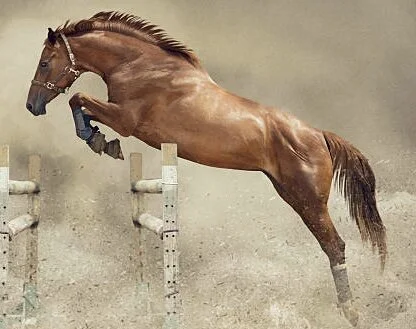Tip #2 Improve Bascule
Farrier Position
Here is a simple exercise that can be done when you are grooming your horse. The purpose of this Masterson Method® technique will help the horse to relax muscles of the lower back, hind end and groin.
Pick up the hind leg and place your fingers under the front of the toe and lift. Support your arms on your thighs to support your back.
Hold the hoof under the front of the toe in this position until you feel the weight of the leg get heavier in your hand. Gradually allow the foot down to the ground. If you meet resistance, refrain from pulling. Your horse is telling you there is tension. Become his ‘shelf’ and wait for him to relax.
Note: He may not be able to hold this position for any length of time.
Down and Back
Another simple exercise is to gently take the leg back and ask him to rest it there. This will help relax the gluteals and hamstrings, relieve lower back tension and relaxes the SI joint. Note the difference in range of motion of the Right Hind Leg in comparison to the Left Hind Leg.
GAME CHANGING PERFORMANCE TIP #2
Improve Your Horse’s Jumping Form
The largest muscle of the hindquarters is called the medius gluteal. There are three gluteal muscles; the superficial gluteal, middle and deep gluteals. For this purpose we are only talking about the middle gluteal.
One point of origin of medius gluteal originates in the longissumus dorsi (the long back muscle). The gluteal ‘tongue’ extends over the entire lumbar spine area inserting on the greater trochanter of the femur.
Together with the long back muscle known as the longissimus dorsi, they assist in lifting the forehand in jumping and galloping for instance. Depending on the discipline these muscles will be used in varying degrees. If pressure points or tension are present it will eventually impede the lumbar vertebrae from being able to lift up.
It is the loin muscles situated along the underside of the spine that are responsible for lifting the back. But, they are not strong enough to counter the gluteals and back muscles. Therefore, as tension accumulates in the gluteals, the horse will no longer being able to lift his back.
TIP: The gluteals extend as far as the end of your saddle area, T16 or T17. Be sure your saddle is not sitting on the gluteal tongue.
Not All is Equal
Note the difference in the range of motion of the Right Hind Leg compared to the Left Hind Leg. Depending on how much tension there is, he may not be able to take it back very far. When you meet resistance refrain from taking it back any further. Simply let him rest it where he is comfortable.



